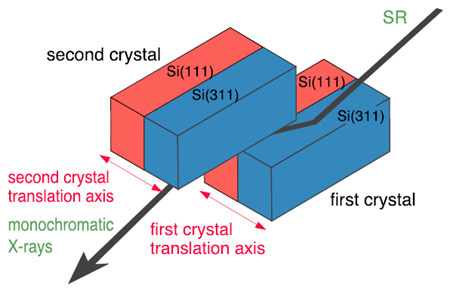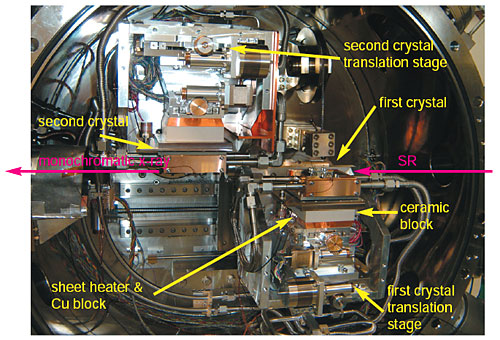The cryogenically cooled monochromator system (Fig. 5-21) with a multi-crystal switching system was developed and installed on the JAERI materials science beam line, BL11XU, at SPring-8. The monochromator crystals will generate heat and will normally deform with this heat load when irradiated by synchrotron radiation (SR). However, if the silicon (Si) crystal is cooled to near liquid nitrogen temperature (-190 degree Celsius), the thermal characteristics of the Si crystal improve, and the crystal can be cooled efficiently. Consequently, high flux X-rays can be obtained.
We use X-rays having energies from 6 to 70 keV in our research. The Bragg angle of the monochromator on BL11XU is restricted to between 3 and 27 degrees due to mechanical limitations. Therefore, only 4.4 to 37.8 keV X-rays can be used with a Si(111) crystal. When using higher energy X-rays, a Si(311) crystal is usually used. A Si(311) crystal can function with X-rays having energies from 8.3 to 72.3 keV. Therefore, depending on the energy range to be used, we must select one or the other crystal. However, three to five days are normally required to exchange the crystals.
To avoid this exchange time, we developed a multi-crystal switching system on the cryogenically cooled monochromator with two diffraction plane crystals held at liquid nitrogen temperature and in a vacuum. The principle of the crystal exchange (Fig. 5-20) is very simple. The two crystals, Si(111) and Si(311), that are exactly the same size are arranged side by side. The crystals are exchanged by translation along the two crystal translation axes. By adjusting only the Bragg angle difference between the two crystals, monochromatic X-rays can be easily obtained. An indium sheet was installed to increase the heat transfer between the crystals and crystal holders. Furthermore, a ceramic block was installed to prevent overcooling of the stages. It prevents the temperature from dropping below the set temperature using a copper (Cu) block with a sheet heater. By this development, the intensity of X-rays has improved by a factor of about seven compared with the diamond(111) crystal that was being used until now. Moreover, it takes only five minutes to exchange the crystals and adjust the crystal geometry. Therefore, we can exchange crystals under liquid nitrogen temperature and vacuum conditions at any time, and we can use wide-range, high-flux X-rays, from 6 to 70 keV, if needed. |

